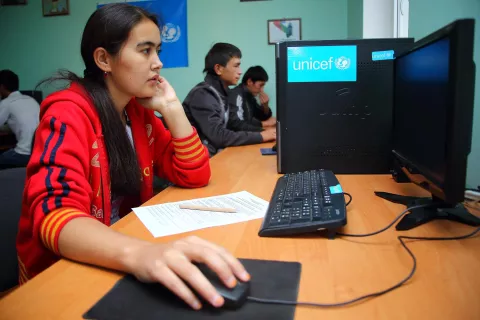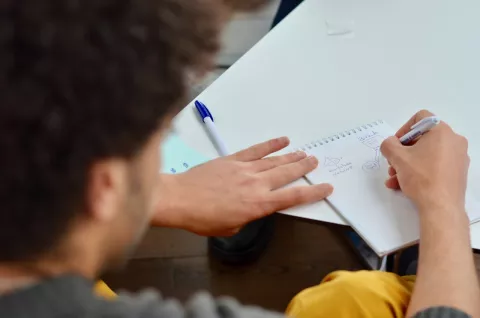Bringing Connectivity to Schools in a Fair & Transparent Way
Exploring where blockchain and Giga intersect

Providing connectivity to the world remains a challenge.
According to the ITU, nearly 3.7 billion people remain unconnected from the internet, and by extension, unable to access digital products and services that could dramatically improve their lives.
UNICEF and ITU have launched Giga, a global initiative to connect every school and it surrounding community to the Internet, connecting every child and young person to information, opportunity and choice. To accelerate this work, UNICEF Innovation is exploring how blockchain, a software that facilitates digital transactions and the basis for cryptocurrency, can be used to increase efficiency and transparency in related areas such as payments, monitoring connectivity and managing digital rules within the Giga ecosystem.
Meet Giga
Giga is an effort anchored in the UN Secretary-General's High-level Panel on Digital Cooperation, which calls for global connectivity and for access to digital public goods.
In summary, Giga has four pillars: (1) Map Every School’s Connectivity, (2) Connect Every School, (3) Finance the Common Bid, and (4) Empower Young People with access to Digital Public Goods. UNICEF has been exploring where blockchain technology can help bring connectivity and digital public goods to young people and their communities in a fair and transparent way.
For more on Giga, visit https://gigaconnect.org.

Blockchain in the Context of Giga

For each Giga pillar, UNICEF has developed prototypes that explore the benefits of blockchain, such as transparency, programmable logic (smart contracts), and cryptocurrency payments. A brief summary of the demos is included below.
Map Every School's Connectivity
Status: Beta

To understand if schools are connected, or require better connectivity than they currently have, a real-time tracking system, enabled by blockchain, can be of benefit. Using either a physical probe, or a browser extension, schools can take a daily internet speed reading and send the information directly to a public blockchain. In doing so, this provides a real-time view into the internet connectivity speed at the school, determining whether the service being paid for is being delivered. Writing the information directly to a blockchain reduces the possibility that the information was tampered with by either the school, internet service provider, or another third party. The information can also act as a foundational layer of trusted information to manage digital rules.
Currently, real-time data is captured and visualized on the Project Connect map to show anyone the speed in the schools.
To explore where blockchain can play a role, a demo has been created.
Connect Every School
Status: Alpha

If a school is connected to the internet, we’re looking at how blockchain can ensure that connectivity is maintained. This could mean helping manage the relationship, the agreement compliance, and execution with the internet service provider. Leveraging smart contracts and real-time data from each school, certain criteria can be automatically monitored and flagged if appropriate (ex. flag is raised when a school’s connectivity has dropped to zero for ten consistent days); payment can also be automatically released when conditions are met.
As the elements of the service agreement are established, the current prototype of smart contract enabled monitoring and payment will be enhanced to match the criteria of the agreement.
See the demo here.
Repo: https://github.com/unicef/unicef-challenge-reducing-digital-divide
Finance the Common Bid
Status: Alpha

To finance connectivity, blockchain can be used as a platform to create greater transparency in the bid process for a region. When bids are placed, this can be logged on a public blockchain as well as publicly show when the bid is assigned. In addition to this, blockchain can be used as a mechanism to show bidders that the financing exists to pay for such services, and publicly track that payments are being made for the service being delivered.
While some initial mock-ups have been created related to how financing the Common Bid can leverage blockchain, the approach and design will be further refined as the process for the bid is concretized.
See the demo here.
Repo: https://github.com/unicef/connect-bc/tree/feature/containerization
Empower Young People with Access to Digital Public Goods
Status: Alpha

Once connectivity is established in communities, there are several opportunities that blockchain can uniquely provide to organizations and governments, as well as individuals. From an institutional perspective, as applications begin to be developed, blockchain provides the underlying infrastructure to share code and create a reputation in a decentralized way. Having such a platform allows for easy sharing of applications in a trusted environment.
For an individual, blockchain creates the opportunity to build reputation across borders in a decentralized way. An individual can collect digital certificates via blockchain and make digital payments through the same infrastructure. Through micro-transactions, individuals can build an informal reputation, unlocking access to new services such as banking or informal identification.
Digital certificates have been investigated by both UNICEF and its investment company OS City. https://certificates.unicef.io/
Bounty systems also provide a global opportunity for remote work; UNICEF has researched and tested bounty-based learning and crowdsourcing of work: https://www.unicef.org/innovation/stories/Boost
There is also ongoing work between the blockchain team and the Digital Public Goods Alliance, with more details to be shared soon.
For updates on our work, follow @UNICEFInnovate & @GigaConnect on Twitter.
Blockchain and Cryptocurrency
A blockchain is a database of information that is distributed on multiple computers at the same time. Blockchains perform three main functions: they store information, track the exchange of value, and can be programmed to perform certain actions automatically (called smart contracts). Public blockchains are immutable, not run by one person or organization, and all transactions are viewable to the public. Blockchain is used to share information between multiple parties to create a common source of truth and to transparently track and share information such as the exchange of value.
One of the major uses for blockchain is storing the transactions or records of the movement of financial value between parties. Systems that use blockchain to record and move financial value are often known as cryptocurrencies - with common examples being bitcoin and ether. While cryptocurrencies are one use case for blockchain, the technology, as a ledger, can be used in many other ways, such as tracking who owns a piece of land or storing education certificates achieved by an individual. To learn more about the basic of blockchain, read this Practical Guide.




